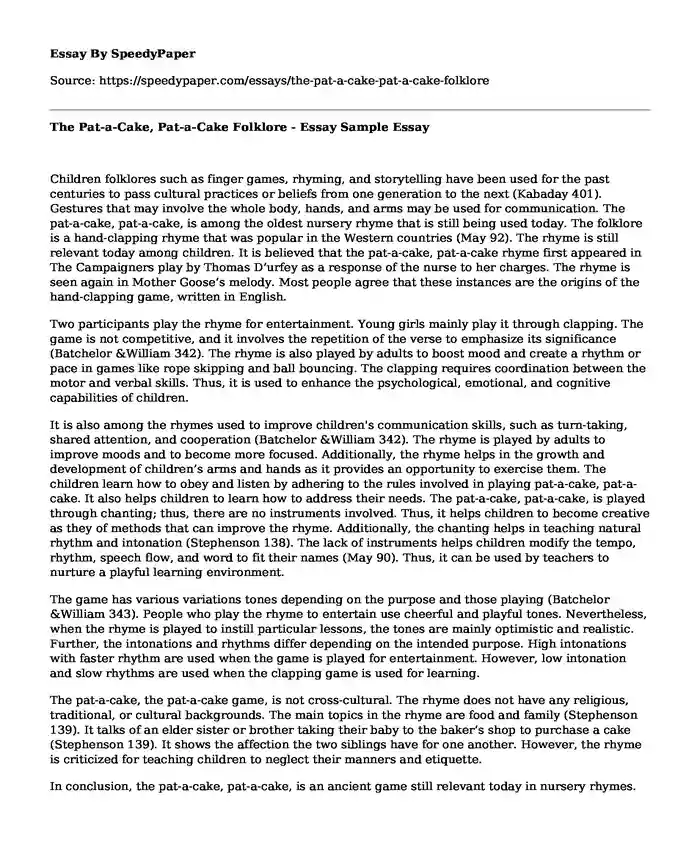
| Type of paper: | Essay |
| Categories: | Literature Child development |
| Pages: | 3 |
| Wordcount: | 709 words |
Children folklores such as finger games, rhyming, and storytelling have been used for the past centuries to pass cultural practices or beliefs from one generation to the next (Kabaday 401). Gestures that may involve the whole body, hands, and arms may be used for communication. The pat-a-cake, pat-a-cake, is among the oldest nursery rhyme that is still being used today. The folklore is a hand-clapping rhyme that was popular in the Western countries (May 92). The rhyme is still relevant today among children. It is believed that the pat-a-cake, pat-a-cake rhyme first appeared in The Campaigners play by Thomas D’urfey as a response of the nurse to her charges. The rhyme is seen again in Mother Goose’s melody. Most people agree that these instances are the origins of the hand-clapping game, written in English.
Two participants play the rhyme for entertainment. Young girls mainly play it through clapping. The game is not competitive, and it involves the repetition of the verse to emphasize its significance (Batchelor &William 342). The rhyme is also played by adults to boost mood and create a rhythm or pace in games like rope skipping and ball bouncing. The clapping requires coordination between the motor and verbal skills. Thus, it is used to enhance the psychological, emotional, and cognitive capabilities of children.
It is also among the rhymes used to improve children's communication skills, such as turn-taking, shared attention, and cooperation (Batchelor &William 342). The rhyme is played by adults to improve moods and to become more focused. Additionally, the rhyme helps in the growth and development of children’s arms and hands as it provides an opportunity to exercise them. The children learn how to obey and listen by adhering to the rules involved in playing pat-a-cake, pat-a-cake. It also helps children to learn how to address their needs. The pat-a-cake, pat-a-cake, is played through chanting; thus, there are no instruments involved. Thus, it helps children to become creative as they of methods that can improve the rhyme. Additionally, the chanting helps in teaching natural rhythm and intonation (Stephenson 138). The lack of instruments helps children modify the tempo, rhythm, speech flow, and word to fit their names (May 90). Thus, it can be used by teachers to nurture a playful learning environment.
The game has various variations tones depending on the purpose and those playing (Batchelor &William 343). People who play the rhyme to entertain use cheerful and playful tones. Nevertheless, when the rhyme is played to instill particular lessons, the tones are mainly optimistic and realistic. Further, the intonations and rhythms differ depending on the intended purpose. High intonations with faster rhythm are used when the game is played for entertainment. However, low intonation and slow rhythms are used when the clapping game is used for learning.
The pat-a-cake, the pat-a-cake game, is not cross-cultural. The rhyme does not have any religious, traditional, or cultural backgrounds. The main topics in the rhyme are food and family (Stephenson 139). It talks of an elder sister or brother taking their baby to the baker’s shop to purchase a cake (Stephenson 139). It shows the affection the two siblings have for one another. However, the rhyme is criticized for teaching children to neglect their manners and etiquette.
In conclusion, the pat-a-cake, pat-a-cake, is an ancient game still relevant today in nursery rhymes. Two children mainly play rhyme, and it is predominantly played by girls. It is a hand-clapping game that involves repetition and chanting of particular words. Varying tones, intonations, and intonations can play the game depending on the intended purpose. However, the rhyme does not have any cultural or religious backgrounds.
Works Cited
Batchelor, Katherine E., and William P. Bintz. "HandClap Songs Across the Curriculum." The Reading Teacher 65.5 (2012): 341-345. https://eric.ed.gov/?id=EJ961029
Kabadayi, Abdülkadir. "Enhancing early literacy development of the children via finger games." New Trends and Issues Proceedings on Humanities and Social Sciences 3.1 (2017): 401-408. https://doi.org/10.18844/gjhss.v3i1.1794
May, Brittany Nixon. "The Rhyme and Reason for Nursery Rhymes in the Elementary Music Classroom." General Music Today 33.2 (2020): 90-96. doi/abs/10.1177/1048371319880875
Stephenson, Jean. "Recite, play and pronounce English joyfully with rhymes and chants!." (2016).137-144, https://dialnet.unirioja.es/servlet/articulo?codigo=5429363
Cite this page
The Pat-a-Cake, Pat-a-Cake Folklore - Essay Sample. (2023, Dec 16). Retrieved from https://speedypaper.net/essays/the-pat-a-cake-pat-a-cake-folklore
Request Removal
If you are the original author of this essay and no longer wish to have it published on the SpeedyPaper website, please click below to request its removal:
- Essay Sample on Continuous Professional Development
- Free Essay on the Purpose of the Sequential Organization of the Novel The Circle by Dave Eggers
- Free Essay Example - Blood Brothers
- Compare and Contrast Paper on The Theories of Piaget and Vygotsky
- Fall Prevention in Long Term Care Facility. Essay Sample
- Fire in the Southwest Proposal - Essay Sample
- Vocational Education in China - Paper Example
Popular categories




